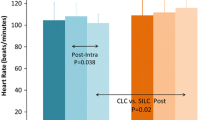Abstract
Background
Intermittent work breaks are common in fields with high workload but not yet for surgeons during operations. We evaluated the effects of intraoperative breaks during complex laparoscopic surgery (5 min every half hour) on the surgeon.
Methods
Fifty-one operations were randomized to a scheme with intraoperative breaks and release of the pneumoperitoneum (intermittent pneumoperitoneum (IPP)) or conventional conduct (CPP). Stress hormones and α-amylase were determined in the surgeon’s saliva pre-, intra-, and postoperatively. Mental performance and error scores, musculoskeletal strain, and continuous ECG were secondary endpoints.
Results
Regular intraoperative breaks did not prolong the operation (IPP vs. CPP group: 176 vs. 180 min, p > 0.05). The surgeon’s cortisol levels during the operation were reduced by 22 ± 10.3% in the IPP vs. the CPP group (p < 0.05). There were significantly fewer (p < 0.05) intraoperative events in the IPP vs. the CPP group, which yielded higher α-amylase peaks. The pre- to postoperative increase in the error rates of the bp-concentration test was fourfold reduced in the IPP group (p = 0.052). The relevant locomotive strain-scores were grossly reduced by IPP (p < 0.001).
Conclusions
Our data support the idea that work breaks during complex laparoscopic surgery can reduce psychological stress and preserve performance without prolongation of the operation time compared with the traditional work scheme.





Similar content being viewed by others
Notes
Correction factor for complexity (cf): Mean results for every procedure were referenced to the most abundant operation in this series (pyeloplasty, which was assigned the factor 1.0).
\( {\text{Cf}} = {\frac{{{\text{over}}\;{\text{all}}\;{\text{mean}}\;{\text{duration}}_{{({\text{operation}}\;{\text{type}})}} }}{{{\text{over}}\;{\text{all}}\;{\text{mean}}\;{\text{duration}}_{\text{pyeloplasty}} }}} \)
\( \Upsigma {\text{cf}}_{{{\text{IPP}}\;{\text{or}}\;{\text{CPP - group}}}} /n_{{{\text{operations}}\;{\text{IPP}}\;{\text{or}}\;{\text{CPP}}\;{\text{group}}}} = {\text{mean}}\;{\text{cf}}_{{{\text{ IPP}}\;{\text{or}}\;{\text{CPP}}\;{\text{group}}}} \)
\( {\text{mean}}\;{\text{cf}}_{{{\text{ IPP}}\;{\text{or}}\;{\text{CPP}}\;{\text{group}}}} \times {\text{mean}}\;{\text{duration}}_{{{\text{IPP}}\;{\text{or}}\;{\text{CPP}}\;{\text{group}}}} = {\text{corrected}}\;{\text{duration }} \)
References
Farmer E, Brownson A (2003) Review of workload measurement, analysis and interpretation methods (CARE-Integra-TRS-130-02-WP2). 1130 Brussels, Belgium, Rue de la Fusée 96: Eurocontrol
AICC. Guidelines for simultaneous translation. http://www.aiic.de/english/suche_arten2.php. Accessed 2008
Kilian H (1957) Hinter uns steht nur der Herrgott [“Behind us only god”]. Kindler Publishers, München, pp 1–385
Brookhuis KA, de Waard D (2002) On the assessment of (mental) workload and other subjective qualifications. Ergonomics 45:1026–1030, discussion 1042–1046
Janssen WH (2004) Route planning and route guidance: a review of the literature (Report IZF 1979-C13). Instituut voor Zintuigfysiologie, Soesterberg
O’Donnel RD, Eggemeier FT (1986) Workload assessment methodology. In: Boff KR, Kaufmann L, Thomas JP (eds) Handbook of perception and human performance. Volume II, cognitive processes and performance. Wiley, New York, pp 42/1–42/49
DT (determination) test www.schuhfried.at. Accessed 2008
Wickens CD (1991) Processing resources and attention. In: Damos DL (ed) Multiple-task performance. Taylor & Francis, London, pp 3–34
Mulder G, Mulder LJM (1980) Coping with mental workload. In: Levine S, Ursin H (eds) Coping and health. Plenum Press, New York, pp 233–258
Leung AW, Chan CC, Ng JJ, Wong PC (2006) Factors contributing to officers’ fatigue in high-speed maritime craft operations. Appl Ergon 37:565–576
Wickens CD (1992) Engineering psychology and human performance. Harper Collins, New York
Nater UM, La Marca R, Florin L, Moses A, Langhans W, Koller MM, Ehlert U (2006) Stress-induced changes in human salivary alpha-amylase activity—associations with adrenergic activity. Psychoneuroendocrinology 31:49–58
Holder G (2006) Measurement of glucocorticoids in biological fluids. Methods Mol Biol 324:141–157
U.S. Department of Defense (1999) Human engineering program process and procedures (MIL-HDBK-46855A)
Brickenkamp R, Yillmer E (1998) The d2 test of attention, 1st U.S. edn. Hogrefe & Huber, Seattle
Hart SG, Staveland LE (1988) Development of NASA-TLX (Task Load Index): results of empirical and theoretical research. In: Hancock PA, Meshkati N (eds) Human mental workload. North-Holland, Amsterdam, pp 139–183
Weston-Lovelock K, Abram A (1996) Establishing the reliability of behaviorally anchored rating scales at the RCB (report no. PLSD/CHS/HS3/CR96055/1.0). DERA, Farnborough
Fitts PM (1966) Cognitive aspects of information processing: III. Set for speed versus accuracy. J Exp Psychol 71:849–857
Damos DL (1996) Multiple-tasks performance. Taylor and Francis Ltd, London, pp 328–360
Kirschbaum C, Hellhammer DH (1994) Salivary cortisol in psychoneuroendocrine research: recent developments and applications. Psychoneuroendocrinology 19:313–333
Rohleder N, Wolf JM, Malsonado EF, Kirschbaum C (2006) The psychosocial stress-induced increase in salivary alpha-amylase is independent of saliva flow rate. Psychophysiology 43:645–652
Kantowitz BH (1987) Mental workload. In: Hancock PA (ed) Human factors psychology. North-Holland, Amsterdam, pp 81–112
Cook NJ (1992) Salivary cortisol and testosterone as markers of stress in normal subjects in abnormal situations. In: Kirschbaum C (ed) Assessment of hormones and drugs in saliva in biobehavioral research. Hogrefe & Huber, Seattle
McCraty R (1998) The impact of a new emotional self-management program on stress, emotions, heart rate variability, DHEA and cortisol. Integr Physiol Behav Sci 33:151–170
Gartner WB, Murphy MR (1979) Concepts of workload. In: Hartman BO, McKenyie RE (eds) Survey of methods to assess workload; AGARDograph no. 246. AGARD, Neuilly-sur-Seine
Hankins TC, Wilson GF (1998) A comparison of heart rate, eye activity, EEG and subjective measures of pilot mental workload during flight. Aviat Space Environ Med 69:360–367
Egan JP (1975) Signal detection theory and ROC analysis. Academic Press, New York
Meister D (1976) Behavioral foundation of system development. Wiley, New York
Acknowledgments
We thank D. Auge and A. Osthaus, MHH for expert help with ECG systems and cardiac output determination, Dr. Judith Orsanu from NASA’s Ames research center in California for discussion, and Prof. R. Dietrich, Humbold University Berlin/Germany for information on simultaneous translation and Mr. Bill Groundwater, Kirkwall/Orkney for help with the manuscript.
Disclosures
This study was financed from the Hannover Medical School general health care budget. Drs. Engelmann, Schneider, Dingemann, Schoof, Ure, and Professors Kirschbaum and Grote have no conflicts of interest or financial ties to disclose.
Author information
Authors and Affiliations
Corresponding author
Rights and permissions
About this article
Cite this article
Engelmann, C., Schneider, M., Kirschbaum, C. et al. Effects of intraoperative breaks on mental and somatic operator fatigue: a randomized clinical trial. Surg Endosc 25, 1245–1250 (2011). https://doi.org/10.1007/s00464-010-1350-1
Received:
Accepted:
Published:
Issue Date:
DOI: https://doi.org/10.1007/s00464-010-1350-1




